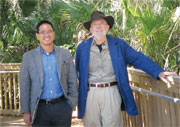
If all had gone as planned, Honore Avenue would be a bustling six-lane highway running south from Manatee County to Englewood.
Instead, the 2.5 mile section just south of busy Fruitville Road is a two-lane road bordered by bioswales and punctuated with roundabouts that accommodate nearly as much traffic as a four-lane highway. Not only do the bioswales collect a significant percentage of pollution, neighbors love the design – and it cost $2.3 million less to build than the county had budgeted for a more traditional alternative.
“It’s important to accommodate automobiles but there needs to be a balance,” says Jon Thaxton, who served on the Sarasota Board of County Commissioners for 12 years before being term-limited out. “There is a balance here: there’s room for automobiles but there’s also a comfortable space for pedestrians and bicyclists – and the environment.”

In fact, the bioswales collect so much nitrogen that they played an important role in “delisting” nearby Roberts Bay. It’s one of the few estuaries in the nation where water quality improved so dramatically that it is no longer considered impaired, notes Jack Merriam, the county’s environmental manager for integrated water resources at the time the Honore Avenue project was built.
Another environmental advantage: the original plan called for clear-cutting about 17 acres of natural forested area to mitigate for drainage from a four-lane road with no bioswales. The final plan required just 1.2 acres of clear-cut land, protecting a mesic hammock and increasing the buffer area for two active bald eagle nests.
Molly Williams, then the lead stormwater engineer for design-build contractor Stantec, worked with the county’s forestry experts, walking the property slated for clear-cutting to identify trees that needed to be saved. What started out as a 17-acre block of land ended up as a series of smaller parcels connected by meandering swales that protected nearly all of the healthy trees. In some areas along the road, boardwalks were used instead of sidewalks to save trees and allow pedestrians to enjoy welcome shade.
Four detention ponds originally planned were reduced to just two, Williams said. Like the bioswales, they’re surrounded by plants that remove nutrients from the water before it gets to creeks that lead to Roberts Bay.
From a traffic perspective, the road with roundabouts keeps cars moving because they don’t need to stop for red lights along the 2.5-mile section. Capacity is about 85% of a traditional four-lane but the number of serious accidents has dropped dramatically because there are no intersections.
“Roadways are like hourglasses,” Thaxton explains. “It doesn’t matter how much capacity you have at the top and the bottom, the volume is determined by the size of the connection in the middle.” Roundabouts slow traffic down but don’t require that cars stop at traffic lights or for left-hand turns. They also nearly eliminate the potential for t-bone crashes that can cause serious injuries.
“Someone would almost have to want to get hurt to have a serious accident on this road,” he said.

Stantec’s senior traffic engineer, Francisco Domingo, also lives in an adjacent neighborhood so the project was particularly near to his heart. He walks the road several times a week, checking for tire marks on the curbs of the roundabouts that might indicate that a driver took the curves too quickly. “People caught on to how to use them even more quickly than we expected,” he said.
And with bioswales built between the road and the sidewalk, pedestrians are protected from careless drivers. “I never thought I’d see it happen, but people come from all over to use this sidewalk to teach their youngsters how to ride a bike,” Domingo said.
At some point, the county may have to compensate a builder who owns land that can’t be developed because of the minor loss of road capacity when compared to a traditional four-lane highway, Thaxton notes. Still, the county saved millions in capital costs and will save even more in maintenance cost over the life of the road. “Nothing is maintenance free, but this is as close as it gets,” Thaxton quips.
No studies have been done to determine exactly how much pollution the Honore Avenue bioswales remove, but some data can be extrapolated from a previous study, Merriam said.
some data can be extrapolated from a previous study, Merriam said. Comparing older neighborhoods with grassy swales to newer neighborhoods with curbs and gutters indicates that the swales collect more than 90% of the nutrients. “And those were just the old-fashioned swales with grass that gets mowed,” he points out. “These are planted with native plants and, in some cases, have specific media designed to hold water long enough to collect nutrients.”
“Honore on Steroids”
The success of Honore Avenue helped persuade Sarasota and the Southwest Florida Water Management District to take the concept a step forward with the redevelopment of Dearborn Street in downtown Englewood. Like Honore, Dearborn will incorporate features like bioswales, rain gardens and pervious paving. It will also be the first-ever project in the county with built-in water quality monitors to document the impact of the construction technology.
The main street through historic Englewood, Dearborn’s redevelopment has been somewhat stymied by the cost of businesses complying with water quality regulations enacted over the last 30 years, Thaxton notes. “What we’ve done is build a collective low-impact development system that allows businesses the (water quality) credits they need to increase their footprint.”
It’s a win-win situation, he adds. “Businesses can afford to grow and the county wins because we have a thriving downtown district with increased property values.”
[su_divider]
Originally published Winter 2013